Human Orbital Spaceflights
![]()
International Flight No. 94Soyuz T-11Soyuz T-10JupiterUSSR |
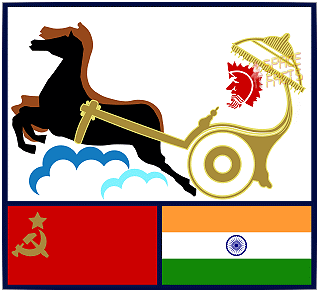 |
![]()
Launch, orbit and landing data
walkout photo |
 |
|||||||||||||||||||||||||||||||
alternative crew photo |
alternative crew photo |
|||||||||||||||||||||||||||||||
alternative crew photo |
alternative crew photo |
|||||||||||||||||||||||||||||||
original crew photo |
alternative crew photo |
|||||||||||||||||||||||||||||||
Crew
| No. | Surname | Given names | Position | Flight No. | Duration | Orbits | |
| 1 | Malyshev | Yuri Vasiliyevich | Commander | 2 | 7d 21h 40m 06s | 126 | |
| 2 | Strekalov | Gennadi Mikhailovich | Flight Engineer | 3 | 7d 21h 40m 06s | 126 | |
| 3 | Sharma | Rakesh "Rikki" | Research Cosmonaut | 1 | 7d 21h 40m 06s | 126 |
Crew seating arrangement
|
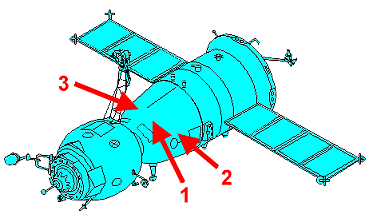 |
|
||||||||||||||||
Backup Crew
|
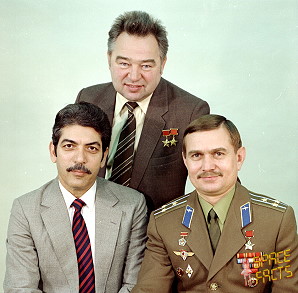 |
||||||||||||||||||||
alternative crew photo |
|||||||||||||||||||||
alternative crew photo |
|||||||||||||||||||||
alternative crew photo |
Hardware
| Launch vehicle: | Soyuz-U (No. Shch15000-395) |
| Spacecraft: | Soyuz T-11 (7K-ST No. 17L) |
Flight
|
Launch from the Baikonur Cosmodrome and
landing with Soyuz T-10 capsule 46 km
east of Arkalyk. Rakesh
Sharma became the first cosmonaut from
India. Following a one-day solo flight Soyuz T-11 docked with the Salyut 7 space station on April 04, 1984 and common work with the third resident crew was performed. The crew conducted scientific and technical studies which included 43 experimental sessions, as Earth observation program concentrating on India and silicium fusing tests. Rakesh Sharma used Yoga techniques to combat the debilitating effects of weightlessness. His work was mainly in the fields of biomedicine and remote sensing. The crew held a joint television news conference with officials in Moscow and Prime Minister Gandhi. As well as environmental studies, photography and investigations into space materials technology, it placed great emphasis on medical experiments with the aim of learning more about the effects of microgravity on the human organism. It is hardest for space travelers during their so-called period of acute adaptation to weightlessness, that is, in the first week of a flight when an abnormal flow of blood to their heads and lungs causes vestibular and circulatory disorders and leads to a marked decrease in efficiency. A series of experiments was carried out to establish what happens to the cardiovascular system. The "Ballisto" experiment, for instance, consisted of recording the micro-movements of the body caused by cardiac activity. The experiment yielded data on the magnitude and spatial distribution of systolic energy and on how conditions during a space flight influence this distribution. These data were of great scientific value as they provided a deeper insight into the processes of vibratory energy conversion along three axes and contained diagnostic information on the state of the systolic function of the heart, of its right and left ventricles. Another experiment, "Vector," was aimed at studying the bioelectrical activity of the heart. A yoga experiment was conducted in orbit for the first time. Rakesh Sharma had studied diverse yoga positions (asanas) before the flight. Five postures were selected for the experiment. Rakesh Sharma did these exercises every day of the flight. It was not an easy thing to accomplish in weightlessness; he had to secure himself in position by finding a rigid point of support. Rakesh Sharma strapped himself to the space station's gym apparatus. The experiment provided a wealth of information on the activity of the back, hip and shin muscles in free exercises, on the biomechanics of various groups of muscles involved in performing the asanas, and on the specific features of muscle control and coordination in spaceflight conditions. The motor and bio electrical activity of the muscles was periodically assessed by special recorders. Thousands of photographs were taken from space and, simultaneously, from a laboratory plane. This was backed up by land and offshore investigations of regions with formations characteristic of the rest of India's territory. The information gathered during this experiment would be used to draw up land usage and coastal zone control maps, as well as in cartography, oceanographic research, the study of the state of forests, inland water bodies and sown areas, mineral prospecting, the building of electric power stations, roads and irrigation canals. Additionally, the crew carried out a number of "Overcooling" experiments under the space materials technology program, designed to study the phenomenon of overcooling in the solidification of molten metals, and to find out what possibilities exist to obtain, in conditions of micro-gravitation, special forms of metallic materials - the so-called "metal glasses" impervious to radiation, high temperatures and aggressive media. The source material was a silver-germanium alloy prepared by an Indian team. Scientists hoped that in space the production of glass-like metals would require only heating and coating. If that hope was justified, they felt it might be possible to set up commercial production of these valuable materials in space, thus facilitating progress in many spheres of science and engineering. The Soyuz spacecraft is composed of three elements attached end-to-end - the Orbital Module, the Descent Module and the Instrumentation/Propulsion Module. The crew occupied the central element, the Descent Module. The other two modules are jettisoned prior to re-entry. They burn up in the atmosphere, so only the Descent Module returned to Earth. The deorbit burn lasted about 3 to 4 minutes. Having shed two-thirds of its mass, the Soyuz reached Entry Interface - a point 400,000 feet (121.9 kilometers) above the Earth, where friction due to the thickening atmosphere began to heat its outer surfaces. With only 23 minutes left before it lands on the grassy plains of central Asia, attention in the module turned to slowing its rate of descent. Eight minutes later, the spacecraft was streaking through the sky at a rate of 755 feet (230 meters) per second. Before it touched down, its speed slowed to only 5 feet (1.5 meter) per second, and it lands at an even lower speed than that. Several onboard features ensure that the vehicle and crew land safely and in relative comfort. Four parachutes, deployed 15 minutes before landing, dramatically slowed the vehicle's rate of descent. Two pilot parachutes were the first to be released, and a drogue chute attached to the second one followed immediately after. The drogue, measuring 24 square meters (258 square feet) in area, slowed the rate of descent from 755 feet (230 meters) per second to 262 feet (80 meters) per second. The main parachute was the last to emerge. It is the largest chute, with a surface area of 10,764 square feet (1,000 square meters). Its harnesses shifted the vehicle's attitude to a 30-degree angle relative to the ground, dissipating heat, and then shifted it again to a straight vertical descent prior to landing. The main chute slowed the Soyuz to a descent rate of only 24 feet (7.3 meters) per second, which is still too fast for a comfortable landing. One second before touchdown, two sets of three small engines on the bottom of the vehicle fired, slowing the vehicle to soften the landing. |
Relocations of Manned Spacecrafts
| Spacecraft | from | Undocking | Time UTC | to | Redocking | Time UTC |
| Soyuz T-11 | Salyut 7 - aft port | 13.04.1984 | 10:27 | Salyut 7 - front port | 13.04.1984 | 10:47 |
Photos / Graphics
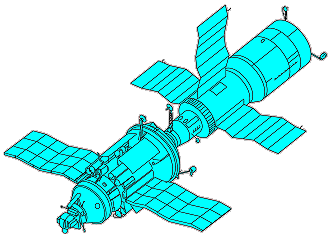 |
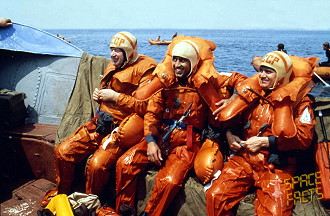 |
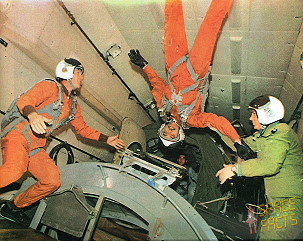 |
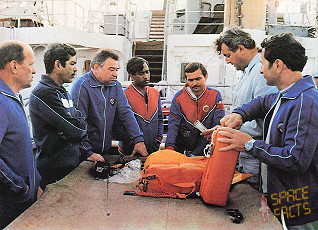 |
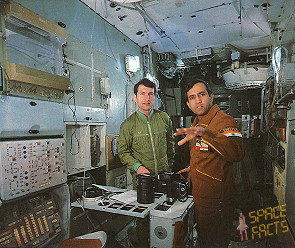 |
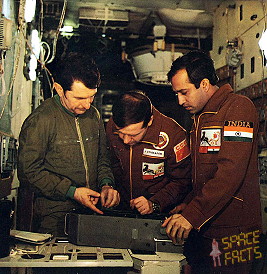 |
 |
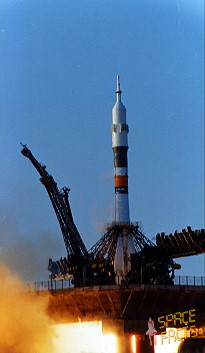 |
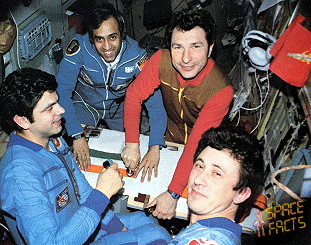 |
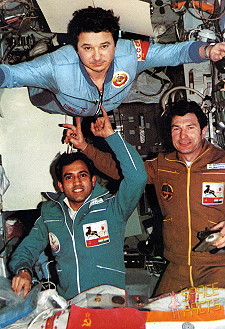 |
 |
 |
 |
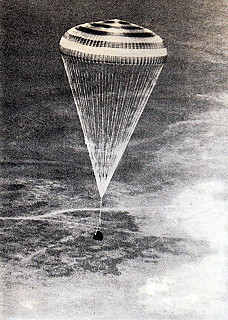 |
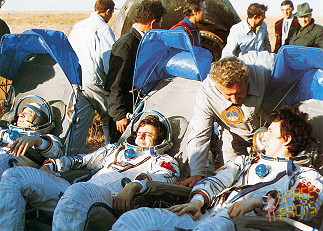 |
| © |  |
Last update on May 15, 2021.  |
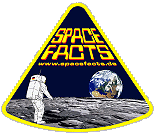 |